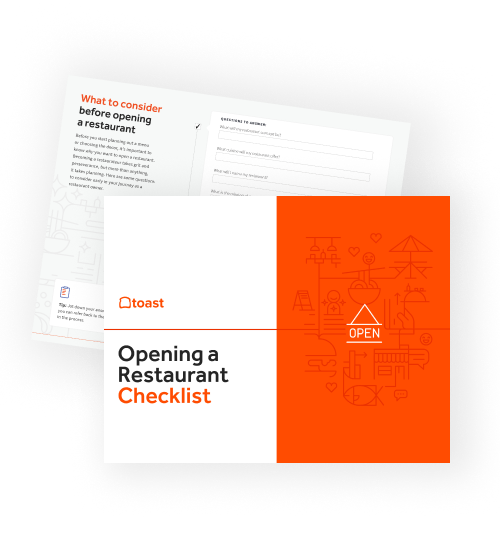
What is a Restaurant Group and How to Structure One for Success
A restaurant group is a clever business to spread your brand and start new concepts. Find out how to structure one here.

Tessa ZuluagaAuthor


Opening a Restaurant Checklist
So many things go into opening a restaurant. Use this free PDF checklist to set your new restaurant up for success.
Get free downloadWhat is a restaurant group
A restaurant group is a business that runs different restaurant concepts under the same company to capture its target audience in different ways.
Opening a restaurant requires an immense amount of carefully thought-out work. To make it in the restaurant industry you must consider several important factors – location, concept, and food, to name a few. If you can succeed in these, you might want to consider expanding into a restaurant group.
A restaurant group is when one singular parent company owns multiple, different restaurants. The restaurant group business idea differs from restaurant chains because each concept is unique, whereas chains are multiple locations of the same concept. Although they require a lot of work, it can be very rewarding for restaurateurs to expand their business this way.
“Being a part of a restaurant group has distinct advantages over owning a singular restaurant,” says Pat Light, the owner of The Light Group. “For example, if you think economies of scale, you are able to order in larger quantities to help mitigate the cost of goods, you then are able to leverage those big orders with companies for them to help your business by driving sales for you, etc.”
In this article, we’ll discuss what a restaurant group entails and how to start & structure one for success.
What is a restaurant group?
A restaurant group is a collection of individual restaurants operating under one common management structure. When you find success in one restaurant, it can enable you to do it again. This structure allows restaurateurs to capitalize on the success of one establishment and replicate it across multiple locations. The restaurants within a group may share organizational structure, staffing, and more. Replicating a proven concept can minimize some of the risks associated with new restaurant openings and provide a solid foundation for expansion.
How do I start a new restaurant group?
Starting a new restaurant group involves careful planning, strategic decision-making, and effective execution. Let’s break down the process.
Start with one restaurant
Start by successfully opening one restaurant. As we mentioned, this requires a lot of work. Once it’s up and running, the average restaurant profit margin is typically only 3-5%. It’s through the learnings from this first experience that you’ll form future growth strategies. This initial restaurant is where you begin to build a loyal customer base. Positive experiences and exceptional service can create a foundation for repeat business and word-of-mouth marketing. In fact, 24% of restaurant goers are still using word of mouth to discover new restaurants.
Financial success in the first restaurant can also provide a solid financial platform for restaurant expansion. A restaurant with strong profits enhances the overall resilience of the restaurant group. Basically, the first restaurant sets the tone for your entire restaurant group. And at the end of the day, the first restaurant will always be the base of your brand.
Find the right talent to expand
One of the great learnings from that first full-service restaurant will be staffing. Restaurant staff aren’t just co-workers, they’re team members. It takes teamwork to make a restaurant flow successfully and give guests a phenomenal dining experience. When hiring your team for new restaurants in the group carefully select your management. It can be helpful if you move a manager from your first restaurant to one of your new ones. This way, the values and operations that have been instilled into your other business can bloom at your others. It’s also nice to keep the restaurants connected, and cross-hiring can enable this.
A successful restaurant group can also become an attractive destination for top talent in the industry. Members of the industry are attracted to restaurants that know what they’re doing. Restaurant groups are proof that you not only know what you’re doing but you were able to successfully do it multiple times. This is just another reason why a restaurant group can be a great business idea.
However, none of this happens without the proper training. Provide comprehensive training to ensure consistency in both service and food quality. Successful training will result in a positive and collaborative work culture to retain top talent. Invest in a strong training program to set your restaurant group up for success.
Training Manual Template
Use this restaurant training manual template, a customizable Word Doc, to provide your staff with the rules, guidelines, and clarity they need to do their jobs efficiently.

Choose a different concept
A restaurant concept is a theme or style that ties together all aspects of your restaurant. It will help you define your cuisine, type of service, decor, atmosphere, and more. It’s crucial to clearly define the concept of each restaurant. This is where you establish what makes each restaurant unique. Offer a variety of dining experiences, or explore niche markets. A well-defined concept can go a long way.
Pat Light told Toast about his different restaurant concepts, “I wanted to revitalize downtown Hoboken [New Jersey] and offer any type of nightlife the consumers wanted, on one corner. We offer live music at River Street Garage, a traditional sports bar with Texas Arizona, a real party atmosphere at Green Rock, a cocktail lounge at The Waiting Room, and a traditional Irish bar at McSwiggans.”
Strategic location placement - There are many perks of having different concepts in your restaurant group. Pat’s example above exemplifies the perk of a so-called “restaurant empire”. This is where all your concepts are within a certain mile radius of each other. This way, when a guest leaves one location they can head to another one under the same group. It also means that locals in that area are likely to pick one of your restaurants, even if they only go out to one that night.
“When I started The Light Group my business model was to acquire the top bars and restaurants in Hoboken [New Jersey] and then apply the successful practices we had established at all the locations,” Pat explained to Toast about his hospitality group.
“This has helped draw more people to that part of town. This is another huge advantage to having a group of restaurants because you don't have to rely on other operators to run a good business and draw people to your part of town, which is one of the biggest keys to having a successful restaurant or bar.”
Market segmentation - You can also tap into market segmentation here. Your group can explore casual dining, fine dining, fast-casual, ethnic cuisine, or specialized themes. Many successful restaurant groups offer completely different cuisines like BRG in Boston, whose restaurants specialize in everything from authentic Mexican tacos to traditional Italian dishes.
Standardize your processes
Standardizing processes is an essential practice when establishing a restaurant group. It involves developing consistent and replicable procedures across all concepts within the group. This standardization plays a crucial role in maintaining quality. Some operations to consider include:
Service - You want guests to have a great experience at all your restaurants. As we described above, training is important. Having a standard process for training can ensure all employees represent your group appropriately.
Quality of food - Standardization contributes to maintaining consistent food and beverage quality. Recipes, cooking methods, and ingredient sourcing can be standardized to ensure that the same level of quality is achieved across all restaurants.
Management styles - Although each restaurant will have different managers, keeping the same employee handbook and management across each restaurant can keep things running smoothly.
Economies of scale - Standardization allows for economies of scale in procurement, inventory management, and supply chain operations. Bulk purchasing and centralized inventory control contribute to cost savings.
Consistent Compliance - This also can ensure that all restaurants within the group adhere to health and safety standards and legal obligations. This consistency can help reduce the risk of regulatory issues.
By implementing standardized procedures, restauranteurs can build an efficient foundation that supports the sustained success of their group.
Work together
Your restaurant group can work together to market and promote loyalty among the different concepts. Develop a marketing strategy to create awareness for your restaurant group.
Your restaurants can work together by creating cross-promotional campaigns. This can include joint promotions, loyalty programs, or themed events that encourage customers to visit different locations. You can also coordinate social media efforts to showcase the variety of concepts within the group. Sharing content across restaurant profiles can increase brand visibility and engage a broader audience. For example, if one restaurant posts about a special they’re running that night the other concepts should repost it as well.
Employee Feedback Template
Use this customizable Word doc to guide self, peer, and manager reviews with your employees.

How do I structure my restaurant group?
Structuring a restaurant group involves designing a framework that facilitates effective management, coordination, and growth. A well-defined structure ensures clarity. Here is how to structure a new restaurant group:
Leadership
At the top of the hierarchy, appoint a CEO or President who oversees the entire restaurant group. This individual is responsible for setting the vision, mission, and strategic direction of the group. However, this doesn’t mean that they do it all alone, and having co-owners can also lead to success.
Operations
An operations division manages day-to-day operations across all restaurants. It includes roles such as regional managers and area supervisors. It’s incredibly useful to have someone going from business to business and making sure the company brand and culture have been kept.
Marketing
This division handles marketing, branding, and promotional activities for the entire group. It may include marketing managers and brand specialists. If your restaurant group gets a lot of inquiries about events from holiday parties to business dinners, this department can focus on organizing them. This team can also plan other promotions to get new customers into the restaurants. Remember, you can always use more marketing even if it’s just to increase lunch sales or slower day sales.
Restaurant Marketing Plan
Create a marketing plan that'll drive repeat business with this customizable marketing playbook template and interactive calendar.

Finance, legal, & human resources
Your restaurant group needs a team that takes care of your business logistics. You need a specialist who manages financial aspects including budgeting, accounting, and financial reporting. You’ll also need a legal team, or at least a lawyer. This team ensures compliance with regulations, licensing, contracts, and any legal matters affecting the group. Lastly, administrative functions, such as human resources, also fall under this category. The breadth of responsibilities assigned to HR team members varies from company to company but is often vast and encompasses everything from recruiting to onboarding, hiring to firing, and much more in between.
Management
At the restaurant themselves you need strong managers, as we mentioned earlier. Each restaurant has a general manager responsible for its day-to-day operations. Then, depending on the complexity of the restaurant concepts, each restaurant may have a chef or culinary director overseeing kitchen operations and menu execution. Some restaurant groups have one executive chef that oversees all the restaurants. Find what works best for your business as long as you remain consistent.
Communication
Last but not least, there needs to be clear communication between all these teams. Consider implementing weekly meetings during the day, before the restaurants get too busy. Or send out regular email notifications or messages. Take advantage of technology like Slack, Microsoft Teams, or any other communication platform.
With great power comes great responsibility
Or maybe we should say with more power comes even more responsibility. Like anything, the more you add to your plate the harder it gets. We’d be doing you a disservice if we only told you about the perks of starting a restaurant group. A business like this requires loads of delegation, strong communication, and focused quality control. Running one restaurant is hard enough work. A restaurant group can only be successful when a full team works together to keep it running. So invest in a strong team, and start expanding your restaurant business today.
Check out these similar resources:
SOPs Template
This template will help you create SOPs for your entire business, so you can create consistency and easily train employees.

Is this article helpful?
DISCLAIMER: This information is provided for general informational purposes only, and publication does not constitute an endorsement. Toast does not warrant the accuracy or completeness of any information, text, graphics, links, or other items contained within this content. Toast does not guarantee you will achieve any specific results if you follow any advice herein. It may be advisable for you to consult with a professional such as a lawyer, accountant, or business advisor for advice specific to your situation.
Subscribe to On the Line
Sign up to get industry intel, advice, tools, and honest takes from real people tackling their restaurants’ greatest challenges.
